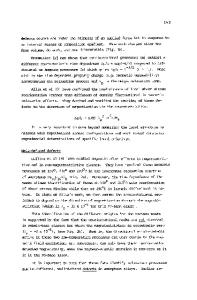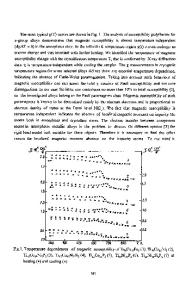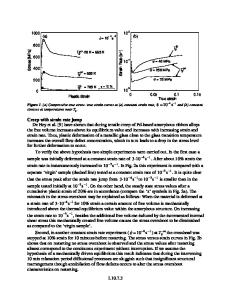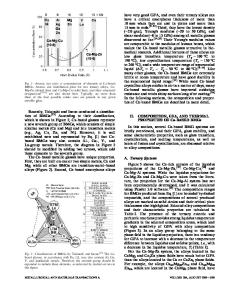Studies of Relaxation of Metallic Glasses by Dilatometry and Density Measurements
- PDF / 862,652 Bytes
- 12 Pages / 420.48 x 639 pts Page_size
- 38 Downloads / 283 Views
STUDIES OF RELAXATION OF METALLIC GLASSES BY DILATOMETRY AND DENS ITY MEASUREMENTS R.W. CAHN*+, N.A. PRATTEN**+, M.G. SCOTT***+, H.R. SINNING**** AND L. LEONARDSSON***** *Recently Universite de Paris-Sud: now Clare Hall, Cambridge; **Dept. of Physics, University of Warwick, Coventry, England; ***Standard Telephone Laboratories, Harlow, Essex, England; ****Institut fUr Werkstoffe, Technische Universit~t Braunschweig, F.R. Germany;*****Dept. of Physics, Chalmers University of Technology, G6teborg, Sweden. +Formerly at Sussex University. ABSTRACT High-precision density measurements on coldrolled Pd 77 . Cu6 Si 6 . glass rods before and after relaxation anneals showed that 30 - 40% rolling leads to a density reduction of --0.14%, recoverable on subsequent annealing below T . This change is about half of the density increase attainable by recovery-annealing the as-quenched glass. Density changes in Fe 4 0 Ni 4 0 B2 0 glass ribbon, resulting from recovery-annealing, were studied indirectly by measuring isothermal length changes through dilatometry of foil sandwiches. The experimental conditions for reliable isothermal dilatometry, using a commercial instrument, are outlined. It was found that the kinetics of length change in the longitudinal and transverse directions were quite different, being faster in the former. Prolonged recovery-annealing prior to dilatometry removed this difference. The intermediate stage of each isotherm followed loqt kinetics. Experiments were performed with Fe40 0Ni40B, Ni64Zra and Cu66Ti3 to search for a reversib e compon nt of length change during cyclic isothermal holds at two temperatures. Such a component probably exists but is extremely small, less than 1% of the limiting irreversible length change. The implications of the various findings are discussed in the light of recent literature. INTRODUCTION The central theme treated in this paper is the change in free volume in a metallic glass resulting from thermal relaxation or plastic deformation, and deduced either by direct density measurement or by uniaxial dilatometry. The work on plastic deformation was done at Sussex University by NAP, MGS and RWC and the dilatometry at the Laboratoire de M~tallurgie Physique of the Universite de Paris-Sud, by HRS, LL and RWC. DENSITY CHANGE DUE TO PLASTIC DEFORMATION The familiar glass of composition Pd Cu Si was selected for this study, because its crit 7 cAI quenching rate for glass formation (-100 K/s) is so modest that thick sections Mat. Res. Soc. Symp. Proc. Vol.
28 (1984) OElsevier Science Publishing Co., Inc.
242
are readily made by water-cooling a silica tube filled with melt. A thick rod is easier than a foil to roll substantially; such a technique is needed since tensile ductility is very small. It is also easier to secure the needed precision in density determination with relatively heavy pieces with a moderate surface-tovolume ratio. The experiments were done with rods about 1.5 mm thick, weighing about 100 mg. The Archimedean technique was used, with diethyl phthalate as displacement
Data Loading...











